Salmon is one of the most popular and nutritious fish available. Rich in omega-3 fatty acids, high quality proteins, vitamins and minerals, salmon can be a super healthy addition to your diet
However like all types of seafood salmon requires proper cleaning and preparation before cooking to avoid any risks of foodborne illnesses.
Within this comprehensive guide, I shall show you how to clean salmon from beginning to end. These tips will help you clean your fish like a pro, whether you just got home with a beautiful fresh salmon or bought frozen salmon fillets at the store.
Why Cleaning Salmon is So Important
Cleaning salmon properly before cooking serves several important purposes:
-
Removes any harmful contaminants or bacteria on the surface of the fish These can cause food poisoning if ingested
-
Gets rid of impurities like sand, dirt and slime. This gives you a clean canvas to work with.
-
Prepares the salmon to better absorb flavors from marinades, rubs and sauces.
-
Removes foul odors for a fresher taste.
-
Allows for more even cooking so no parts are over or underdone.
-
With whole salmon, gutting and de-gilling improves the flavor by removing fishy tasting innards.
-
Cutting into fillets or steaks makes the salmon easier to work with for most recipes.
So let’s get into the nitty gritty details on how to clean your salmon like an expert!
How to Clean Whole Salmon
If you are starting with a whole, fresh salmon, here are the steps:
Step 1: Rinse
Rinse the salmon under cold running water. This removes any dirt, debris or slime from the surface. Be sure to rinse inside the cavity as well if gutted.
Pat dry with paper towels when done.
Step 2: Remove Scales (Optional)
Salmon scales should come off pretty easily. To remove, you can use:
-
A spoon or butter knife. Gently scrape against the grain of the scales.
-
A fish scaling tool. Just run this across the skin from tail to head.
Rinse again after scaling to wash away any debris.
Step 3: Gut the Salmon
Cut along the belly of the salmon from anus to head. Scoop out the entrails and internal organs with your fingers. Give the inside another good rinse.
Step 4: Remove Gills
The gills can give an undesirable “fishy” flavor. Pull them out where they attach at the salmon’s head.
Check for any leftover debris inside and clean it out.
Step 5: Cut and Portion
-
Remove fins and tail if desired.
-
Use a sharp fillet knife to cut salmon into fillets, cutting along the backbone.
-
For steaks, slice the salmon crosswise into your desired thickness.
Step 6: Debone
Run your fingers over the salmon flesh to feel for any pinbones. Use tweezers or pliers to remove them.
For steaks, cut downward against the rib bones to remove them from the fish.
Step 7: Store Properly
Rinse fillets or steaks, pat dry and tightly wrap in plastic wrap. Store in the coldest part of the refrigerator.
Use within 2 days.
Step 8: Wash Up
Wash hands, cutting board, utensils and work area after handling raw salmon. This prevents any cross-contamination.
Cleaning Store-Bought Salmon Fillets
For skinless salmon fillets from the grocery store or fish market, the process is a bit easier. Here’s how to clean salmon fillets before cooking:
Step 1: Rinse
Rinse fillets under cold water and pat dry with paper towels. This helps remove any ice glaze if previously frozen.
Step 2: Check for Bones
Feel for bones by rubbing fingers over fillet. Use tweezers to remove any you find.
Step 3: Portion
If desired, use a sharp knife to cut fillets into smaller portions.
Step 4: Store
Rinse again, pat dry, wrap tightly in plastic wrap and refrigerate. Use within 2 days.
Step 5: Wash Up
Clean work area, utensils and hands after handling.
And that’s it! Your salmon is ready for any recipe.
Top Tips for Cleaning Salmon
-
Invest in a good fillet knife. This makes the process much easier.
-
Work quickly and return cleaned salmon to the fridge within 20 minutes.
-
Cut away discolored flesh. This may indicate spoilage.
-
Under cool running water, rub fillets with your fingers to dislodge any bones.
-
Use paper towels for drying. Cloth towels can harbor bacteria.
-
When gutting, work over a disposable bag to contain entrails.
-
Clean work area thoroughly before and after.
-
Use separate cutting boards for raw salmon and other foods.
Storing Your Cleaned Salmon
Proper storage is just as important as cleaning to keep your salmon fresh and safe. Follow these storage tips:
-
Wrap tightly in plastic wrap or freezer wrap, squeezing out excess air.
-
Place in a container or on a plate to catch any leaks if the wrap breaks.
-
Store raw salmon on the lowest shelf of the fridge, furthest from ready-to-eat foods.
-
Consume within 2 days for optimal freshness.
-
For longer storage, freeze at 0°F or below. Use within 3-6 months.
-
When thawing frozen salmon, do so in the fridge or under cold running water. Never thaw at room temp.
How to Know if Your Salmon Has Gone Bad
Here are some signs that your previously cleaned salmon has spoiled and should be discarded:
-
Strong, fishy odor
-
Slimy texture
-
Discoloration or graying flesh
-
Dull, fading pink/orange color
-
Dry, flaky flesh
-
Visible mold
-
Past the safe use-by date
When in doubt, remember the old adage “When fish smells fishy, throw it out and be done, wishy!”
Frequently Asked Questions
Here are answers to some common questions about cleaning salmon:
Do I really need to rinse my salmon fillets before cooking?
Yes! Rinsing helps remove contaminants, loose scales, bones, blood and slime from the surface. Be sure to pat dry before marinating or cooking.
Is it safe to use the same cutting board for salmon and other foods?
No, you should use separate boards to prevent cross-contamination. Also use different utensils.
Can I freeze cleaned salmon in its original grocery store wrap?
No, you should rinse and dry it, then re-wrap tightly in freezer-safe wrap before freezing.
How can I get rid of the fishy smell?
Rinsing well, removing bloodline and drying helps. Soaking 10 minutes in milk or lemon juice also reduces odors.
Do I need to remove the skin before cooking salmon?
That depends on the recipe. For many cooking methods like grilling or roasting, the skin helps hold the flesh together. Simply peel off after cooking if you don’t want to eat it.
Time to Cook Your Salmon!
Now that you know how to clean salmon properly from start to finish, it’s time to turn this delicious fish into a mouthwatering meal.
Refer back to this guide whenever you need a refresher on the cleaning process. With these simple steps, you’ll have beautifully fresh, contaminant-free salmon ready for cooking anytime.
Some of my favorite salmon recipes include:
- Lemon Garlic Baked Salmon
- Blackened Salmon Tacos
- Salmon Burgers with Avocado Sauce
- Cajun Salmon Salad
- Salmon Teriyaki Bowls
Don’t be intimidated by preparing fresh fish at home. With proper cleaning and handling, salmon is one of the safest, healthiest, and most delicious types of seafood you can enjoy.
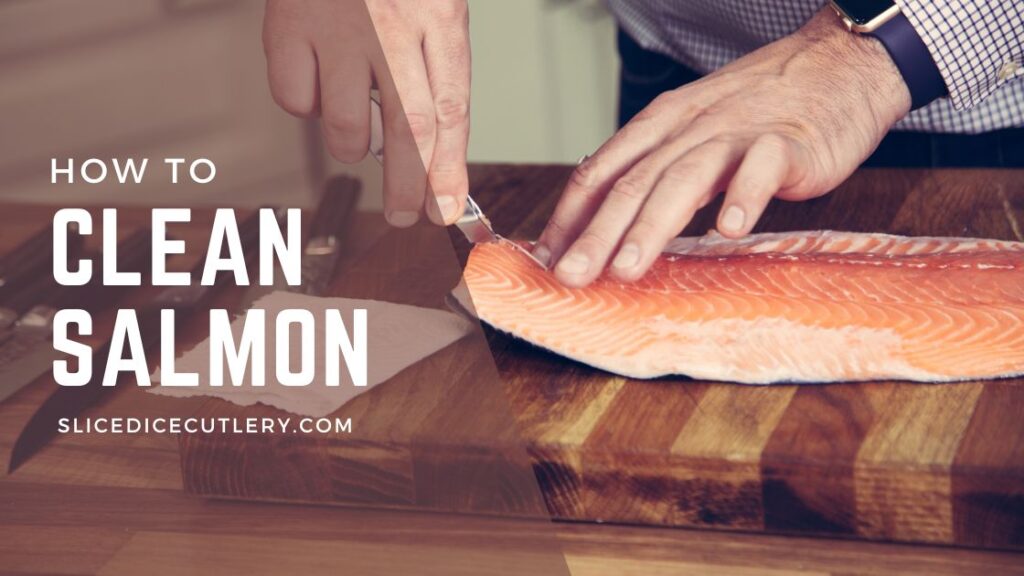
Step 4: Remove the Ribs
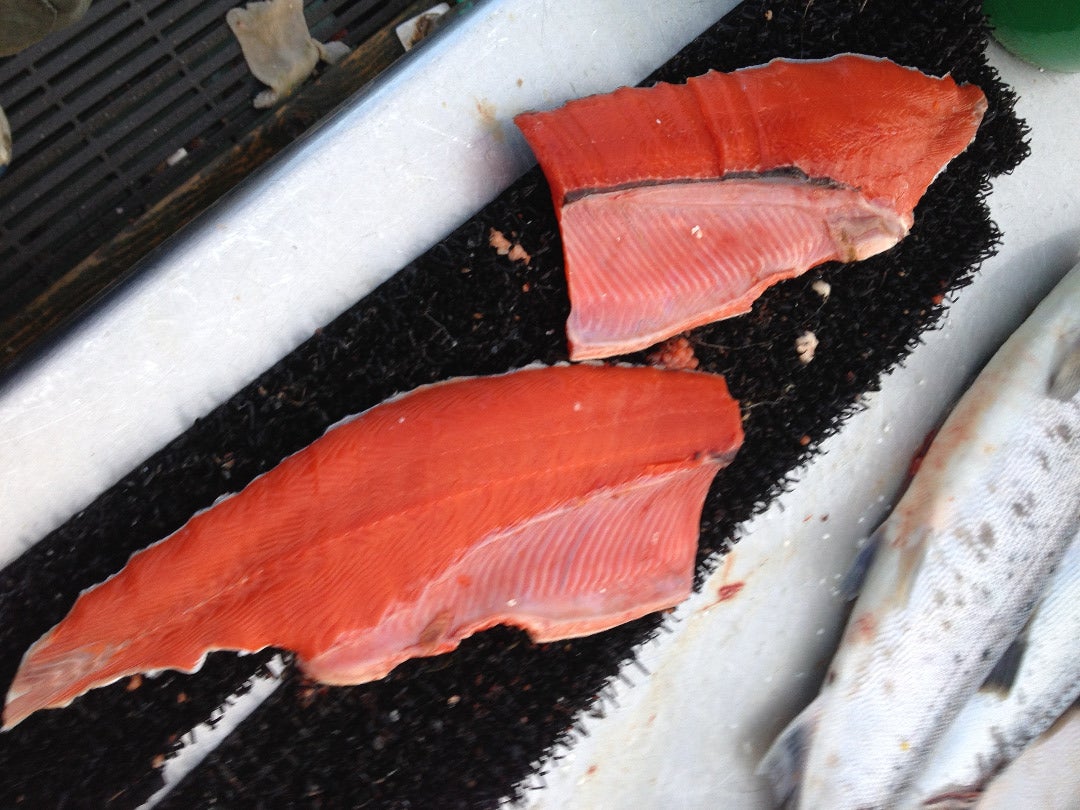

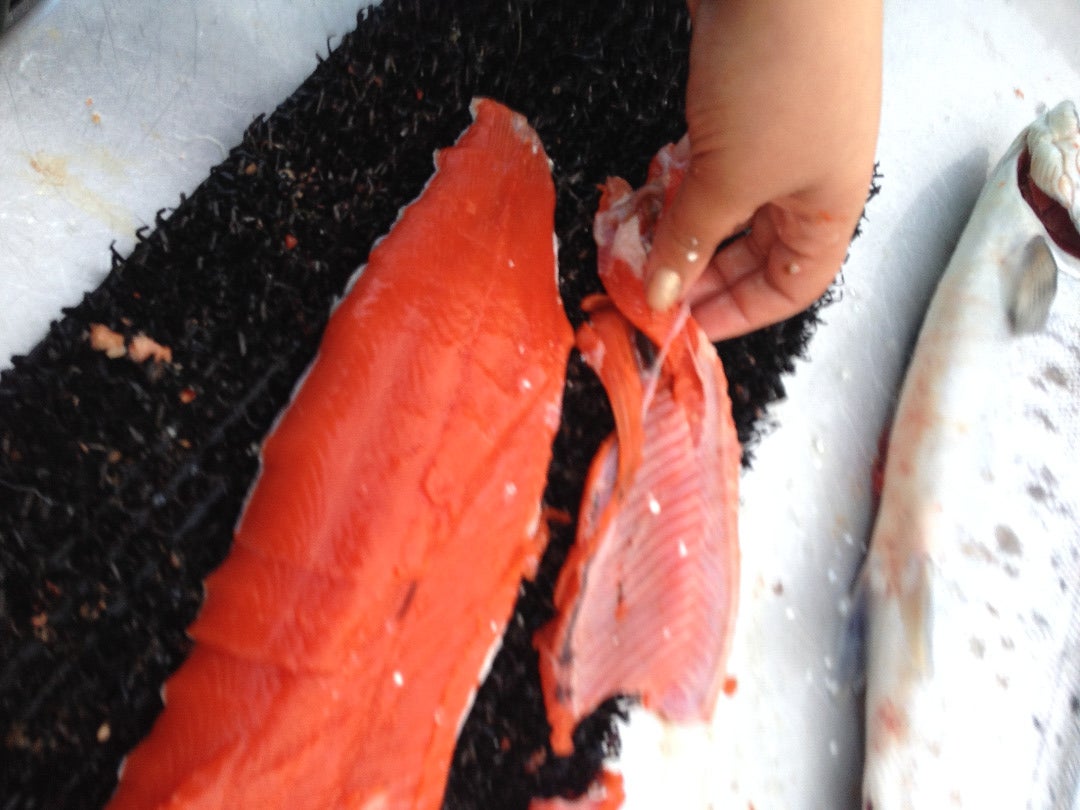
Once you have your fillets cut, you have to go back in and remove the ribs. Put your knife next to the ribs and slowly move it down to the edge of the filet. Do not cut straight down, or you will lose a lot of the filet. Instead, run the knife along the fish’s meat. This will remove the ribs with minimal loss of meat. Dispose of ribs properly.
After you remove the ribs, there will still be pinbones remaining in the fillets. You can use tweezers, needle-nose pliers, or hemostats to get rid of these before cooking the fish, or you can pick them out as you eat it. Removal of the pinbones is easier after the fillets firm up in the refrigerator. Many people prefer to remove all of the bones before any cooking or preparation. Our family does.
Step 1: Remove the Anal Fins and Scale the Fish
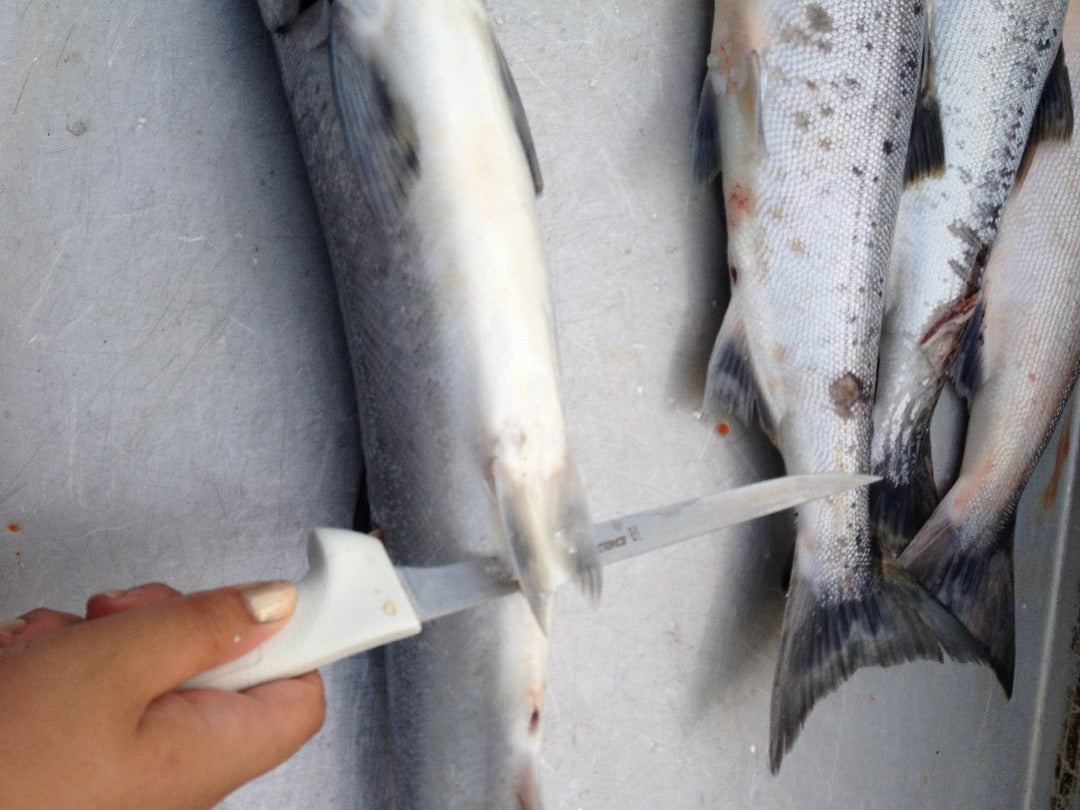
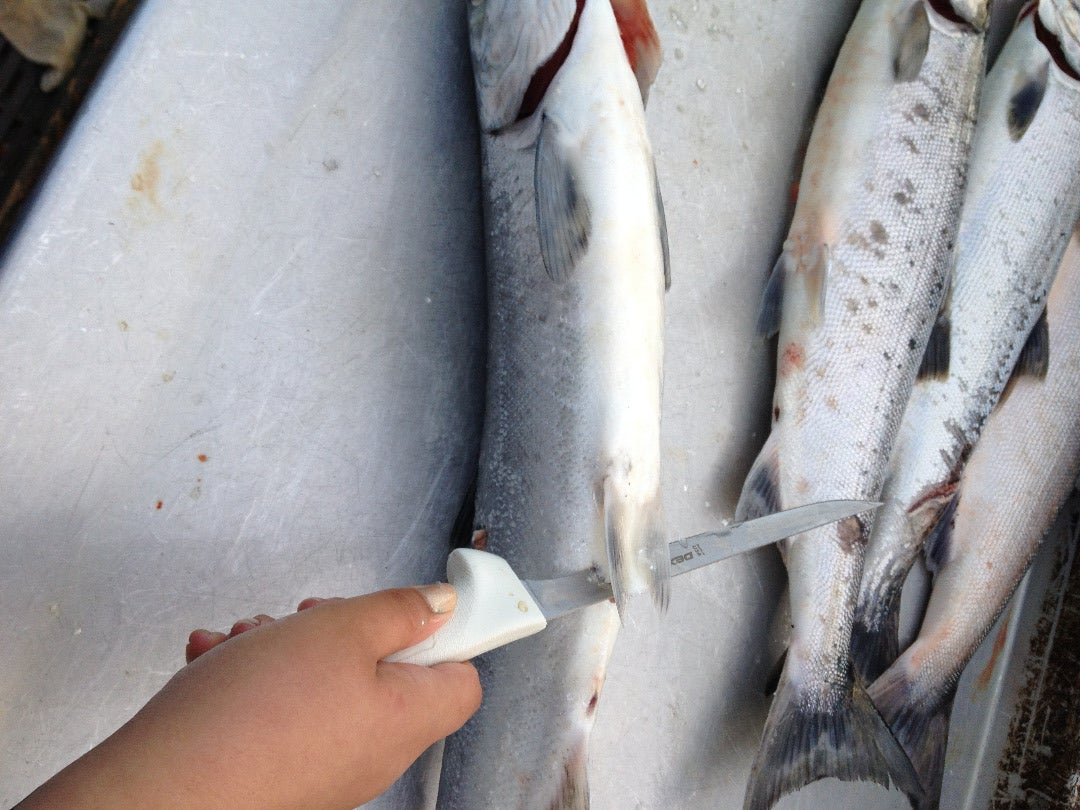


The anal fins are a pair of fins located near the rear of the fish. To get rid of these fins, put your knife behind the anal fins, cut down a little, and then run the knife across the fins. Once these fins are removed, dispose of them properly.
Once the fins are removed, scale the fish. This fish did not have this done, and it was much harder to scale.
If you don’t have more than one dull fillet knife, you can use a sharp one instead. To scale the fish, start at the tail and run the knife down the skin toward the head. Do this repeatedly, and with a fast repeated motion, to completely scale the fish. Make sure that you scale both sides of the fish.
DISCLAIMER:
You do not have to scale the fish, but salmon scales come off easily. It makes it difficult to clean the fillets and cook them if the scales are still on them.
